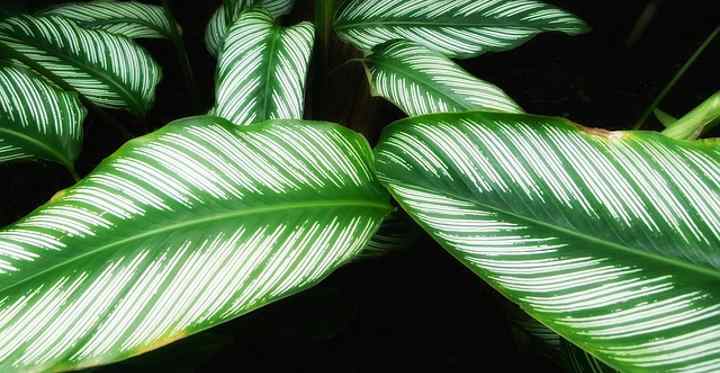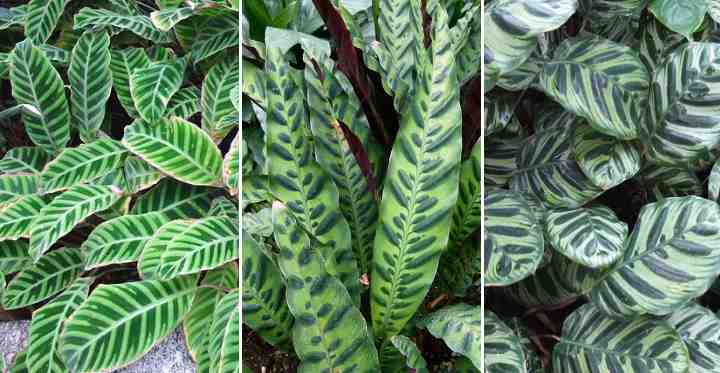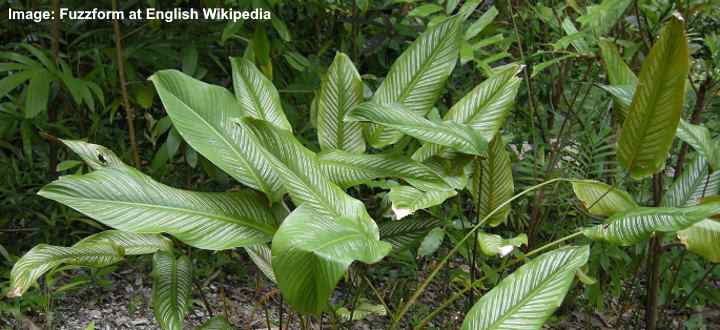Caring for Calathea Ornata (Pinstripe Calathea) – The Ultimate Guide

Calathea ornata is a houseplant with large dark green glossy leaves and striking white or pink stripes. Sometimes called the Pinstripe Calathea, this perennial evergreen plant grows in tropical regions of the world. Its large attractive stripy pink leaves make the calathea ornata a beautiful plant that livens up any room or office. Calatheas are houseplants that are easy to care for and thrive indoors.
How to Care for Calathea Ornata (Pinstripe Plant)
To care for a calathea ornata, place the houseplant in plenty of bright, indirect light and grow in well-draining, peat-based potting mix. Keep room temperature between 65 and 80°F (18 – 27°C) with high humidity. Water pinstripe plants regularly so that the soil is always moist, and fertilize every four weeks throughout the growing season.
What is a Pinstripe Plant?

There are over 300 calathea cultivars, and the calathea ornata is one of the largest species. Calatheas belong to the family Marantaceae and are closely related to prayer plants (marantas).
Sometimes calatheas are called prayer plants because they raise their leaves at night like prayer plants. In the evening, the leaves of calathea plants fold upright at the base of the stem, as if the plant is folding its leaves upward to pray. This process is called nyctinasty.
Sometimes the leaves of calatheas curl up from the outer edges inward toward the central vein because something is wrong in their environment. To prevent leaf curl make sure to keep your calathea plant in warm, humid and away from direct sunlight. Make sure your houseplant has partly moist soil.
Pinstripe calathea plants are clump-forming plants and grow to about 2 ft. (60 cm) tall. Their glossy green leaves have thin white or pink lines.
Two types of calathea ornata plants are the ‘Sanderiana’ and ‘Roseo lineata’ cultivars. The common name “pinstripe plants” comes from the pink or white stripes radiating out from the center spine of the leaf. Similar to many species of calathea, pinstripe plants have deep purple or burgundy undersides.
Although pinstripe plants rarely flower indoors, it’s the stunning pink or white fish-bone patterns on its leaves that make this house plant so desirable. These large houseplants make a great statement as a colorful tropical houseplant.
Other Types of Calathea

In the picture from left to right: Zebra plant (C. zebrina), Rattlesnake plant (C. lancifolia) and Peacock plant (C. makoyana)
The calathea ornata (pinstripe plant) is just one of the many types of calatheas to choose from. Calathea houseplants have leaves that can be ovate or lanceolate-shaped. Many species also have colorful green, cream, and pink patterns on the leaves.
Other common varieties of calatheas include Peacock Calathea (C. makoyana) with light green feathering on leaves and a purple underside, ‘Rattlesnake plant’ (C. lancifolia) that has lance-shaped green leaves with dark green spots, and the ‘Dottie’ (C. roseopicta) with dark purple leaves and pink variegation.
Calathea Ornata Care Advice
Pinstripe plants are easy to grow at home. However, they have a few specific care requirements. The most essential growing tips when it comes to the calathea ornata species is to get the watering and humidity right.
This calathea ornata care guide gives you all the necessary advice on caring for this tropical houseplant.
Calathea Ornata Light Requirements

Calathea ornata grows well when it gets plenty of indirect sunlight
Place a pinstripe plant in a bright location where there is plenty of indirect sunlight. Although this houseplant grows well in low light, bright light will keep the leaves glossy and the pink stripes vibrant. For healthy growth, your plant needs between 6 and 8 hours of light.
The best place for a calathea ornata is in an east- or west-facing room near a window. If you have your plant in a south-facing room, keep it away from the window or shade it from direct sunlight. With plenty of bright light, you will notice that the creamy-white pinstripes turn to pink as the calathea plant matures.
If you notice that the leaves show signs of burning, move the plant to a shadier location, away from direct sunlight.
If you live in zones 10 and 11, calatheas will thrive outdoors. Their large foliage makes them excellent as ground cover plants in partial shade. You can also move a calathea ornata outdoors in summer if you live in a temperate climate. Just remember to bring the delicate plant inside if the temperature drops below 60°F (15°C).
How to Water a Pinstripe Plant (Calathea Ornata)
To care for a calathea ornata, water it regularly in the growing season and less frequently in winter. You know when a pinstripe plant needs watering when the soil is partly dry. Provide deep watering when the top 1” (2.5 cm) of soil is has dried out.
How should you water a calathea houseplant properly? Pour enough water in the soil until it drains out the bottom. When the water has stopped dripping, you can put your calathea back in its bright place.
So, gently press the soil in the pot. If it is dry and no moisture seeps up, you know it is time to water your topical houseplant. The frequency of watering depends on several factors. For instance, you will need to water more often in summer than in winter.
The best care tip for watering a calathea ornata is not to let the soil become soggy or too dry. Too much moisture in the soil can lead to root rot and several fungal or bacterial diseases. If the soil completely dries out, you see that the leaves become withered and start to become crinkly.
When watering a calathea ornata, it is best to use water at room temperature. The lukewarm water avoids shocking the plant and encourages healthy growth.
Calathea Ornata: Temperature
Because pinstripe plants grow in tropical regions, average room temperatures are ideal. A constant temperature of between 65°F and 80°F (18°C – 27°C) will create the perfect growing environment. As long as they get enough indirect light and are kept at room temperature, caring for these plants should be easy.
The challenge of keeping your calathea ornata healthy comes in hot summers or cold winters. Switching on the air conditioning or heating can quickly change the air temperature and humidity.
Keep calatheas away from cold drafts—air conditioning flows in summer or open windows in winter. Also, when you switch on the household heating, make sure your houseplants are well away from direct heat.
Humidity Requirements for Calathea Ornata
Calatheas love humid conditions, and you should mist a calathea daily to ensure adequate humidity. Other ways to keep the air moist include using a humidifier or setting your plant pot on a pebble tray with water. During winter, you should mist your pinstripe plant more often.
Average rooms tend to have less than 50 percent humidity, which is too dry for calatheas. If the environment is too dry, your calathea ornata leaves may develop brown edges. One of the mistakes caring for calatheas is to up humidity by over-watering. Remember, it is best to spritz the leaves with a fine spray than water too much.
If you don’t have time to mist the leaves once or twice a day, use a pebble tray. The best way to create enough humidity is to fill a small tray with pebbles. Pour enough water in the dish so that it is half-way up the stones. Place your calathea ornata on the pebbles. The evaporating water will help keep the leaves moist.
Be careful—never allow your calathea ornata pink plant pot to sit directly in water. Your calathea may start to die as too much moisture damages the roots.
The Best Soil for Growing Calathea Pinstripe Plants
Calatheas need to grow in soil that is well-draining but still keeps some moisture. The best potting mix for pinstripe plants is this: two parts peat moss, two parts perlite, and one part potting soil. This type of light, aerated potting medium allows excess water to drain while holding essential nutrients.
If you want to buy suitable potting soil for calathea pinstripe plants, then African violet potting mix is ideal.
One trick to help the soil drain better is to add a layer of clay pebbles at the bottom of the pot. These stones help to aerate the soil. This care tip not only helps with draining but allows the nutrients of the soil to nourish healthy houseplants.
It is also advisable to avoid putting decorative stones over the top of the soil. Although this can help keep the potting mix moist, it prevents evaporation. The lack of moisture from the soil can cause leaves to turn color if there is not enough humidity.
You can grow calathea ornata plants in denser soil, but you will have to adjust the watering.
Fertilizer to Care for Calathea Ornata
The most fertilizing a pink pinstripe calathea needs is weak houseplant food every four weeks. Calatheas generally have few feeding requirements when growing indoors. However, occasionally providing balanced nutrients will keep the green and pink foliage looking healthy and vibrant.
If using a regular houseplant fertilizer, dilute it to half strength to avoid over-feeding. The time to feed your calathea is monthly from April through October. These are the months when houseplants grow.
A common mistake when caring for plants in the Marantaceae family is giving them too much fertilizer. In this respect, always err on the side of caution and don’t feed too frequently. If you notice that leaves start turning yellow or the stems wilt, flush the soil to get rid of excess mineral salts. To do this, pour in enough water until it drains out the bottom of the pot.
How to Repot a Pinstripe Calathea Plant
Calathea pinstripe plants can grow up to 2 ft. (60 cm) tall and require repotting every two years. Choose a pot that is 1” to 2” (2.5 – 5 cm) wider than the current container. The best time to transfer your pink pinstripe plant is in spring when it starts growing.
Repotting prevents the plant from becoming rootbound—a pot packed with roots stunts growth and prevents proper soil drainage.
To repot your beautiful calathea ornata, gently remove the plant from its pot. Shake off excess soil and check roots for any signs of damage, such as rot. Prune as necessary. The container should have 3 or 4 drainage holes in the bottom. Put a layer of clay pebbles on the bottom and half-fill with new, fresh calathea potting mix. Repot your calathea to the same depth it was before. Fill with potting mix and gently press down. Water thoroughly and put in a bright location.
Calathea Ornata Care: Pruning Tips
Calatheas require very little pruning, and any pruning is just for aesthetic purposes. Calathea ornata is a naturally bushy type of houseplant with large stripy leaves. Pruning is only required to trim off brown parts of the leaves. You should also prune off dead or yellow leaves.
Although the occasional yellow leaf is nothing to worry about, yellowing leaves could be signs of common calathea problems. At the end of the article, you will find out how to care for a calathea that has yellow leaves.
How to Propagate Calathea Ornata
These attractive house plants with pink stripes are easy to propagate. The most effective way to grow new pinstripe calatheas is by root division. Unlike their cousins marantas (prayer plants), calatheas don’t propagate well from stem cuttings rooted in water. The best time to propagate is in spring when you repot your plant.
To propagate a calathea, prepare a new pot with a moist potting mix. Remove the calathea from its pot and shake all the soil from the roots. Divide the root segments, leaving a few stems with leaves on each part. Then place the divided plant in its new pot and follow the potting instructions above.
You can also cover the propagated calathea with plastic to help increase moisture levels. When the new plant starts growing, you can remove the cover and return it to a bright location with indirect sunlight.
Are Calathea Ornata Plants Toxic?
The good news is that calathea ornata plants are not poisonous for dogs, cats, or humans. There are no reports of other common pets such as birds, rodents, or rabbits suffering adverse reactions from eating calatheas leaves. (1)
Calathea Ornata Flowers
Calathea ornata plants are kept as houseplants for their striped leaves and pink lines. The indoor environment is not favorable for Calatheas to flower and they rarely—if ever—flower indoors.
In their native habitat in the tropics, pinstripe calatheas have small clusters of orange flowers. Even in the wild, the orangey-colored flowers are secondary to the stunning pink striped leafy foliage on calathea ornata plants.
Calathea Ornata Care Advice: Pest and Diseases
Pinstripe plants are not prone to common houseplant pests and diseases. However, sometimes spider mites, aphids, or mealybugs can afflict these houseplants. Also, because calathea ornata needs high humidity, fungal diseases can affect the plant if you get moisture levels wrong.
How do you care for a calathea that has pests? You can use a neem oil organic solution to get rid of bugs from your calathea ornata.
Find out more about natural ways of getting rid of aphids and other pests from your pinstripe plant.
The most common cause of bacterial or fungal diseases is too much moisture. Excessive moisture can cause pseudomonas blight or fusarium fungal diseases. If you think that your plant is diseased, it’s essential to remove all the soil from the roots, sterilize the pot, and repot in fresh sterile soil.
Why Does Your Calathea Pink Pinstripe Plant Have Yellow Leaves?
There can be several reasons why leaves on your calathea pinstripe plant have started turning yellow. Here are some of the most common reasons:
- Old leaves turn yellow and can be pruned off. These yellow leaves are entirely natural and nothing to be concerned about.
- Watering issues are the most common reason why many calathea ornata leaves become yellow. Check the soil for moisture and adjust your watering schedule as necessary.
- Too much sunlight is also a common reason for leaf burn that causes yellow or brown patches. Move the plant away from direct sunlight.
- Over-feeding can turn many leaves of calathea yellow. To resolve this problem, flush the soil with plenty of water and don’t feed your plant for a few weeks.
Related articles:
